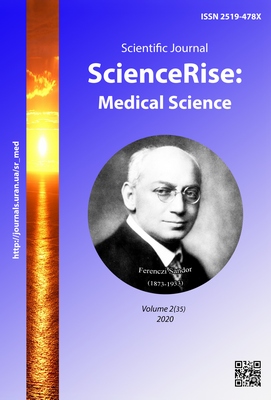Деякі аспекти безпеки енісаміуму йодиду назального спрею: результати доклінічних досліджень
DOI:
https://doi.org/10.15587/2519-4798.2020.199597Ключові слова:
гостра місцевоподразнювальна дія, Енісаміум Йодид (назальний спрей), назальна ендоскопія, одноразове введення, релевантна шкала оцінкиАнотація
Мета. Обґрунтування безпеки використання нового назального спрею з Енісаміумом Йодидом за результатами дослідження гострої місцевоподразнювальної дії досліджуваного препарату одноразовому введенні у кон'юнктивальний мішок та носовий хід кролів.
Матеріали та методи. Енісаміум Йодид 10 мг/мл (назальний спрей) був об'єктом тестування. Референтним препаратом був 0,9 % розчин натрію хлориду. Для індукції експерименту використовували кролів породи Фландр (Фламандський Гігант) (2 групи, по 9 кролів у кожній групі). Об'єкти дослідження вводили одноразово в очні кон'юнктивальні мішки (0,01 мл) та носові ходи (0,1 мл) шляхом інстиляції. Очний огляд ми проводили в різні часові точки спостереження (через 1, 24, 48 та 72 години після введення препаратів). Назальна ендоскопія застосовувалася для контролю стану слизової оболонки порожнини носа на всіх стадіях дослідження (за 15 хвилин до, 1 годину та 24 години після інстиляції лікарських засобів) під загальною анестезією. Шкала оцінки використовувалася для об'єктивності результатів.
Результати. Загальний бал становив 0 балів у всіх групах у всі періоди часу спостереження за відповідною шкалою та шкалою оцінки слизової оболонки порожнини носа кролів за результатами ендоскопії носа. Це відповідає стану здорового ока та здорової слизової оболонки носа.
Висновки. Енісаміум Йодид 10 мг/мл (назальний спрей) при одноразовому введенні в кон'юнктивальний мішок та носовий хід кролів не виявляв ммісцевоподразнювальної дії на кон'юнктиву ока та слизову порожнину носа у експериментальних тварин. Назальна ендоскопія може бути використана як інформативний візуальний метод у доклінічних дослідженнях
Посилання
- Kwah, J. H., Peters, A. T. (2019). Nasal polyps and rhinosinusitis. Allergy and Asthma Proceedings, 40 (6), 380–384. doi: http://doi.org/10.2500/aap.2019.40.4252
- Çelik, M., Kaya, K. H., Yegin, Y. et. al. (2019). Anatomical Factors in Children with Orbital Complications Due to Acute Rhinosinusitis. Iranian Journal of Otorhinolaryngology, 31 (106), 289–295.
- Sella, G. C. P., Tamashiro, E., Anselmo-Lima, W. T., Valera, F. C. P. (2017). Relation between chronic rhinosinusitis and gastroesophageal reflux in adults: systematic review. Brazilian Journal of Otorhinolaryngology, 83 (3), 356–363. doi: http://doi.org/10.1016/j.bjorl.2016.05.012
- Mengko, S. K., Soemantri, R. D., Juniati, S. H. (2018). Correlation Between Objective Evaluation Result of Nasal Congestion and Life Quality in Patients with Acute Rhinosinusitis. Indian Journal of Otolaryngology and Head & Neck Surgery, 71 (3), 1929–1934. doi: http://doi.org/10.1007/s12070-018-1333-4
- De Boer, D. L., Kwon, E. (2019). Acute Sinusitis. StatPearls. Treasure Island (FL): StatPearls Publishing. Available at: https://www.ncbi.nlm.nih.gov/books/NBK547701/
- Fokkens, W. J., Lund, V. J., Mullol, J. et. al. (2012). European position paper on rhinosinusitis and nasal polyps. Rhinology, 50 (23), 1–298.
- Ministry of Health of Ukraine. Universal clinical protocol for primary, secondary (specialized) and tertiary (highly specialized) medical care. Acute rhinosinusitis (2016). Order of the Ministry of Health of Ukraine, 85, 17–24.
- Zhulay, T. S., Shebeko, S. K., Zupanets, I. A. (2017). The study of the dose-dependent antiexudative effect of a new anti-inflammatory nasal spray. Clinical pharmacy, 21 (4), 11–16. doi: http://doi.org/10.24959/cphj.17.1446
- Zhulai, T. S. (2018). The preclinical study of a new nasal spray with the anti-inflammatory properties: the effect on the leukotriene-induced inflammation. Clinical pharmacy, 22 (4), 27–33. doi: http://doi.org/10.24959/cphj.18.1473
- Zhulai, T., Shebeko, S., Goy, A. (2018). Perspectives for use of the new nasal spray with anti-inflammatory action in treatment of acute rhinosinusitis. Rhinology, 56 (27), 585.
- Zupanets, I. A., Popovich, V. I., Zhulai, T. S., Volosovets, O. P., Shebeko, S. K., Kryvopustov, S. P. et. al. (2019). Pharmaceutical care of patients in acute rhinosinusitis treatment. Kharkiv: Golden pages, 36.
- Kovalenko, V. M., Tsypkun, O. G. (2007). Preclinical study of the local drug-induced irritant action. Kyiv: St. Pharm. Center, 13–31.
- Parliament, European & Council, European (2010). DIRECTIVE 2010/63/EU on the protection of animals used for scientific purposes. EU Official Journal. L276. Available at: https://eur-lex.europa.eu/LexUriServ/LexUriServ.do?uri=OJ:L:2010:276:0033:0079:EN:PDF
- Turner, P. V., Pekow, C., Vasbinder, M. A., Brabb, T. (2001). Administration of Substances to Laboratory Animals: Equipment Considerations, Vehicle Selection, and Solute Preparation. Journal of the American Association for Laboratory Animal Science, 50 (5), 614–627.
- Flecknell, P. A. (2016). Laboratory Animal Anesthesia. Oxford: Academic Press, 350. doi: http://doi.org/10.1016/c2013-0-13494-0
- Islam, M. A., Al-Shiha, A. (2018). Foundations of Biostatistics. Springer Nature Singapore Ltd. doi: http://doi.org/10.1007/978-981-10-8627-4
- Quirk, T. J., Quirk, M. H., Horton, H. F. (2016). Excel 2016 for Biological and Life Sciences Statistics: A Guide to Solving Practical Problems. Springer International Publishing Switzerland. doi: http://doi.org/10.1007/978-3-319-39489-3
##submission.downloads##
Опубліковано
Як цитувати
Номер
Розділ
Ліцензія
Авторське право (c) 2020 Tetiana Zhulai, Igor Zupanets, Sergii Shebeko, Stanislav Zimin, Kateryna Yampolska

Ця робота ліцензується відповідно до Creative Commons Attribution 4.0 International License.
Наше видання використовує положення про авторські права Creative Commons CC BY для журналів відкритого доступу.
Автори, які публікуються у цьому журналі, погоджуються з наступними умовами:
1. Автори залишають за собою право на авторство своєї роботи та передають журналу право першої публікації цієї роботи на умовах ліцензії Creative Commons CC BY, котра дозволяє іншим особам вільно розповсюджувати опубліковану роботу з обов'язковим посиланням на авторів оригінальної роботи та першу публікацію роботи у цьому журналі.
2. Автори мають право укладати самостійні додаткові угоди щодо неексклюзивного розповсюдження роботи у тому вигляді, в якому вона була опублікована цим журналом (наприклад, розміщувати роботу в електронному сховищі установи або публікувати у складі монографії), за умови збереження посилання на першу публікацію роботи у цьому журналі.










